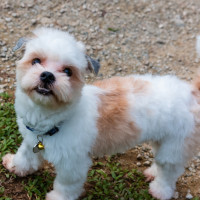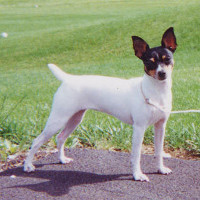 |
Fo-Tzu |
|
He is not recognized by the F.C.I. |
Origin |
Tibet <> U.S.A. -> U.S.A. | |
Translation |
Francis Vandersteen | |
This breed is also known as |
Toy Fo-Tzu |
A brief presentation of the Fo-Tzu |
| The Fo-Tzu is a cross between the Shih Tzu and the Toy Fox Terrier. Both are small breeds, so your Fo-Tzu will also be a small dog, measuring around 33 centimeters and weighing around 5 kilos on average. They have medium to long coats that are generally soft, smooth and fine like hair rather than fur. They come in almost any color combination, but the most common are black and white or brown and white. This breed may not be suitable for families with young children or new pet owners, as they can be lively and stubborn. |
History of the Fo-Tzu |
| To understand this seemingly rare but adorable hybrid breed, it's crucial to understand its origins. Knowing the parents of a mixed breed, both in type and in size and temperament, can shed light on what you can expect from a specific litter of mixed puppies. The Fo-Tzu is a cross between the Shih Tzu and the Toy Fox Terrier. Size, physical appearance and temperament are mainly based on these two breeds. After all, a hybrid breed is designed to bring out the best qualities of both parent breeds. |
A little of the Shih Tzu |
||
| Shih Tzu originated in Tibet, where they lived in temples in ancient times. During the Tang dynasty (618-907), they were used as guard dogs and companions of royalty, and were sometimes given as gifts to Chinese emperors. Believed to be part of the Lhasa Apso and Tibetan Mountain Dog, they were later mixed with Pekingese to become the more traditional Shih Tzu you see today. During the Chinese Revolution, the breed almost died out, with only seven females and seven males left. From these 14 dogs, the rest of the Shih Tzu breed was rebuilt and became popular in other countries such as England, Norway and the USA. Because of the similarities between the Shih Tzu and the Lhasa Apso, they were still confused until a standard was developed in 1938 to describe the Shih Tzu's broader skull and less curved tail. At the end of the Second World War, some soldiers brought these little dogs back with them to America, and they were officially recognized by the American Kennel Club in 1969. Today, they are the 20th most popular dog breed in the United States. | ||
 |
||
| Standard of the Shih Tzu | ||
A little of the Toy Fox Terrier |
||
| The Toy Fox Terrier is a direct descendant of the British Fox Terrier. Anecdotally, American breeders discovered that the biggest characters in the litter were the biggest characters in the litter. In the early 20th century, they then bred the toys to create a miniature version of the Fox Terrier with an amplified personality. Chihuahuas and Italian Greyhounds were added to the mix, providing greater genetic diversity and choice for breeders. Many describe the resulting Toy Fox Terrier as a dog with the fiery nature of any Terrier, but with a knee-jerk temperament. Traditionally, these dogs were kept as both pets and vermin hunters. They have also appeared in circus acts, their intelligence and cheeky nature making them perfect for the part. Today, they are kept as pets, show dogs and successful competitors in canine activities such as agility. | ||
 |
||
| Presentation of the Toy Fox Terrier |
Appearance of the Fo-Tzu |
| This breed is available in all color combinations, but is usually seen in gold, white, cream, brown, beige and black. Their medium to long coat looks more like hair than fur, and generally doesn't cause allergic reactions. Some have large heads and short muzzles, like the Shih Tzu, but most have small heads and longer muzzles, like the Toy Fox Terrier. These are small dogs that can weigh around 5 kilos on average and stand around 33 centimeters tall. They have long, slender legs, big black eyes, large pointed ears and a black or dark brown nose. |
Temperament of the Fo-Tzu |
| This breed is not ideal for first-time dog owners, as they can be stubborn and difficult to train. In addition, they are not good with young children and have been known to bite when teased. However, they like other dogs when well socialized and can get along with cats if trained. Many people who own a Fo-Tzu use puppy pads because they're so difficult to train, but if you're consistent and patient, you should be able to train him eventually. Stick to positive reinforcement rather than physical punishment. They're smart but stubborn, and can sometimes be too lazy to listen. |
Needs and activities of the Fo-Tzu |
| The Fo-Tzu can be a bit lazy if you let it, so you'll need to make sure you give it enough exercise to keep it from gaining too much weight. They need around 45 to 60 minutes of moderate to strenuous activity every day. This could include a walk with your dog in the morning and evening, a long game of fetch, a hike in the park or even a trip to the local dog park. They may also enjoy agility training and playing Frisbee if they're more like Toy Fox Terriers than Shih Tzus. |
Maintenance of the Fo-Tzu |
| To keep your Fo-Tzu's coat and skin healthy, you need to brush them at least four or five times a week. It's best to use a wire brush for regular grooming and a smoother brush for tangles and mats. This breed tends to have skin problems, so you should check with your vet what type of shampoo and soap to use, if any. However, don't bathe them too often, as this dries out their skin. You should also clean their ears once a week with a damp cotton pad and watch for earwax build-up, mites and redness, as Shih Tzu's are sensitive to ear infections. Also, trim their nails if necessary. |






 English (United Kingdom)
English (United Kingdom)